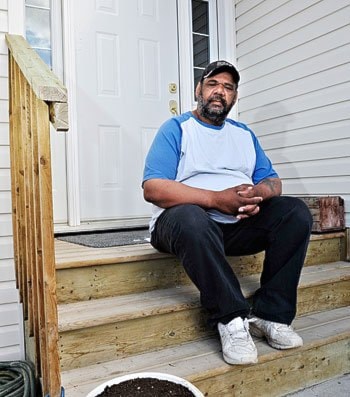CARCROSS
‘You realize that stuff there … if it starts sinking, we’re going to lose the crane,” a lanky, grey-haired crane operator tells the site manager.
Travis Johnston’s brow furrows under his bright orange safety helmet, which has been personalized with a prominent skull and crossbones sticker.
He considers the warning.
The 26-year-old with gold earrings and a soul patch for facial hair is in charge for now, until his dad, Mike, makes it into town.
They’ll just have to load the crane on the fill slowly and back off at the first sign of trouble, Johnston decides.
They can’t wait until tomorrow to get another load of fill.
Johnston wants the next pilings in that afternoon.
They’ll just have to keep using the sand already on the beach, and hope it’s a solid enough base for the crane.
The backhoe goes back into action.
It’s already mid-June and fewer than half of the supports for the new 110-metre Nares River (Natasaheeni River) footbridge are in place.
The race is fully on.
The water-work had to wait until the Arctic grayling emerged in the early spring. The most disruptive in-stream steps are mandated to happen in the dead-zone until the end of June.
After that, the construction company needs to meet another ecologically induced deadline: the bulk of the lake trout migration.
“With the fish window, we have to have all the pilings in place before the end of July. After that, we can’t actually work in the water,” Johnston said.
The crew is working seven days a week to meet the deadline.
The old blue-and-grey wood footbridge across the Nares River was condemned after being deemed a liability in the fall of 2005.
Some Carcross residents ignored the barriers and continued to use the decaying wooden structure as a fishing platform.
Many walkers switched to using the old train bridge just a short jaunt away.
The revival of train traffic into town, with the renaissance of the Carcross portion of the White Pass rail route this year, shut down public access to the rail bridge and brought the need of a new foot crossing to the forefront of funding proposals.
The Yukon government and the Canada Strategic Infrastructure Fund each kicked in half of the $3 million cost for a number of upgrades to Carcross’ waterfront in January 2005.
Johnston Construction out of the East Kootenays was awarded the contract for the construction while local firm EBA Engineering designed the bridge’s supports.
The new bridge features steel pilings, steel girders and steel cross-braces, with a wooden deck (“probably fir”) built to accommodate a viewing deck at the north end of the beach, and fishing alcoves along its length.
Half of the dozen in the construction crew are local, including two journeyman carpenters, a welder and a first-aid attendant. The rest are from the Kootenays.
The crane was shipped in three semi-loads from Ontario.
As a condition of the contract, the construction crew must also demolish and cart away the old footbridge.
“It’s in really bad shape. We had to rip the deck off of it. All those wood pilings were hit by pieces of ice and they’re all broken,” Johnston says.
High water is already slowing progress. In order to pull out the old pilings and drive in the new ones next door, the construction crew has to build out a solid support into the channel so that the crane can get close enough to the action.
The crane support consists of piles of sand and rock upon which the crew lays heavy-duty pre-assembled wood decking, brought on trucks from BC.
When the water level rises, as it did last week, the crew has both less working area and less temporary fill as the beach disappears.
Also, the higher the water level, the higher the pile of fill needs to be in order to give the crane enough clearance over the water.
Johnston Construction should be out of Carcross in three months, but as the company also replaces car-deck bridges it may not be out of the Yukon for long.
“The majority of the bridges in the Yukon were built when they were doing the Alaska Highway. They’re Bailey bridges that are past their prime,” Johnston says.
“There are a lot of bridges in this area that need to be replaced, so I think the company is going to be up here quite a bit more.”
